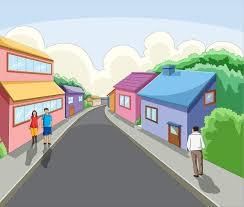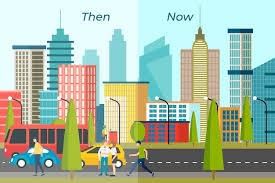Class 7 Exam > Class 7 Notes > Footprints Class 7: Book Solutions, Notes & Worksheets > Chapter Notes: Locality - Then and Now
Locality - Then and Now Chapter Notes | Footprints Class 7: Book Solutions, Notes & Worksheets PDF Download
| Table of contents |

|
| Understanding Our Locality |

|
| Localities: Then and Now – Societal Changes Over Time |

|
| Drivers of Change: Understanding Causes |

|
| Effects of Change: Understanding the Impact |

|
Understanding Our Locality
- A locality is simply the area around where you live. It includes all the places where people live, called settlements. These settlements can be hamlets, villages, towns, or cities. Your locality consists of places like your house, school, marketplaces, bus stops, places of worship, shops, your friends' houses, and other important spots.
- Most localities have things like roads, schools, parks, banks, houses, and various other structures, which are the backbone of every community.

Types of Localities
- Villages, Towns, and Cities: We all live in one of these. Towns and cities are known as urban areas, while villages are in rural places. In rural areas, people mainly work on the land, focusing on agriculture, animal husbandry, and fishing. On the other hand, those in towns and cities are mostly involved in secondary and tertiary sector jobs.
Localities Then and Now
- Past: In old times, villages, towns, and cities were built in specific locations close to important resources like rivers, fertile lands, or trade routes.
- Present: Nowadays, people choose where to live for different reasons. They look for more than just basic resources; they seek localities that offer all the facilities and amenities for a comfortable and enjoyable life.
Localities: Then and Now – Societal Changes Over Time
Localities change over time. Let's look at how a fictional rural area from the 1960s compares to today's world. We will explore how things have evolved and what has stayed the same.

Locality in 1960
- Population: The locality had a smaller population with residents living in traditional homes.
- Housing Types: Mostly traditional homes with courtyards and open spaces.
- Construction Material: Locally sourced materials like mud bricks and thatched roofs were common.
- Amenities: Limited amenities like electricity and basic sanitation.
- Transportation: Walking and bicycles were the primary modes of transportation, with a few buses or rickshaws for longer journeys. Private car ownership was rare.
- Public Transport: Limited public transport with no metro or extensive train networks.
- Access to Education: Limited access to education, with few schools and higher education institutions located in larger cities.
- Traditional Classrooms: Education was conducted in traditional classrooms with minimal use of technology.
- Agriculture: Farming was the primary livelihood, with traditional crops like rice, wheat, millet, and pulses being grown. Farming was labor-intensive and subsistence-based.
- Traditional Crafts: Some residents were engaged in traditional crafts like pottery and weaving.
- Limited Services: Services like healthcare, banking, and finance were limited, with few industrial jobs.
- Communication: Communication was through written letters, with limited access to landline telephones and telegrams.
- Healthcare: Basic healthcare with rudimentary technology and limited medical facilities.
- Entertainment: Radio, cinema, and local cultural events were primary sources of entertainment. Traditional festivals were major community events.
- Natural Resource Utilization: Resource use was based on immediate needs, with limited environmental conservation efforts.
Locality Today
- Population: The population has increased significantly due to urbanization, improved economic opportunities, and migration.
- Housing Types: Diversified housing, including modern apartments, high-rise buildings, and single-family homes.
- Construction Material: Modern, durable materials like cement, steel, and concrete are used in construction.
- Amenities: Improved amenities, including widespread electricity, sanitation, and internet connectivity.
- Transportation: Increased use of private cars and motorbikes, with expanded public transportation systems including metro and train networks in larger towns.
- Public Transport: Well-developed public transport systems with extensive networks and metro services in urban areas.
- Access to Education: Increased access to education with more schools, colleges, and universities, even in smaller towns.
- Technology Integration: Widespread use of technology in education, with smart classrooms and online learning becoming common.
- Agriculture: Agriculture has diversified, with a broader range of crops being cultivated, including cash crops and high-yield varieties. Farming has become more commercialized and mechanized.
- Job Diversification: The economy has diversified, with growth in the service sector, manufacturing, and technology-related jobs.
- Communication: Widespread use of mobile phones and the internet, with improved access to information and communication.
- Healthcare: Advanced healthcare facilities with modern technology, better-equipped clinics, and access to more medical services.
- Entertainment: Television, internet streaming services, and multiplex cinemas have become popular sources of entertainment. Mobile devices and apps have transformed how people access entertainment.
- Environmental Awareness: Increased environmental awareness with conservation efforts, legislation, and proactive initiatives to protect natural resources.
What Has Changed
- Population Growth
- Housing Types and Construction Material
- Amenities and Infrastructure
- Transportation and Public Transport
- Access to Education and Technology Integration
- Agricultural Practices and Crop Diversification
- Economic Diversification
- Communication and Healthcare Advancements
- Entertainment Preferences
- Environmental Awareness and Conservation Efforts
What Has Prevailed
- Cultural Diversity and Community Bond
- Traditional Crops and Farming Culture
- Architectural Heritage
- Community Involvement in Festivals and Traditional Practices
- Continued Use of Public Transport and Bicycles
- Traditional Values in Education
- Community Ties and Artisanal Skills
Question for Chapter Notes: Locality - Then and NowTry yourself: Which of the following is a characteristic of localities in the past?View Solution
Drivers of Change: Understanding Causes
Localities change over time due to various reasons. These changes can be slow or fast and can greatly affect how people live and interact in a place.
Let's explore some key reasons behind these changes:
- Historical factors: Many areas change because of events that happened in the past. For instance, building forts, palaces, and temples often led to the growth of nearby areas as people settled there for trade and safety.
- Agricultural practices: In the old days, localities often changed because of how people farmed. New irrigation systems, different crops, or shifts in who owned the land could alter local communities.
- Trade and commerce: The creation of trade routes and markets had a big impact on shaping localities.
- Urbanization: The fast growth of cities is a major reason why localities in modern India are changing. Rural areas are becoming more urban as people move to cities for better jobs and living conditions.
- Infrastructure development: Building roads, highways, airports, and public transport systems can bring significant changes to localities by making them more connected and accessible.
- Industrialization: When industries grow in certain places, more people move there for work, new jobs are created, and supporting infrastructure develops.
- Technological advances: Technology and the Internet have changed how people live and work in localities. Online shopping and digital services have affected both urban and rural areas.
- Environmental factors: Changes in the environment, like natural disasters or climate change, can have a big impact on localities. Flooding or landslides, for example, can force communities to move.
- Government policies: Rules set by the government about how cities should be planned, how rural areas should develop, and what land can be used for can greatly influence how localities grow.
- Cultural and social changes: When societal norms, values, and ways of living change, it can affect localities. The influence of media and globalization has brought many changes to different places.
- Population growth: When more people start living in an area, localities expand, new housing is built, and more services and facilities are needed. The past 50-80 years have seen a huge increase in population due to advances in healthcare, lower death rates, and better farming practices.
Effects of Change: Understanding the Impact
Indian society has changed a lot over time, and these changes have affected many parts of people's lives.
Let's look at how these changes have made a difference:
- Improved Living Standards: Changes in society have made life better for many Indians. They now have easier access to things like education, healthcare, clean water, and sanitation.
- Increased Urbanization: More and more people are moving from rural areas to cities. Cities offer better jobs and facilities, but they also have problems like too many people and pollution.
- Cultural Diversity: India has a lot of different cultures, and these have been both preserved and changed by society's shifts. People in India now experience various cultures from within the country and around the world.
- Economic Growth: Changes in the economy have helped India become a strong global economic power. New industries and services have created jobs and improved the country's economy.
- Gender Equality: Society is now more aware of gender equality issues. There have been improvements in women's rights, education, and jobs, even though there are still problems to solve.
- Environmental Challenges: Cities growing quickly and more industries have caused problems like pollution and cutting down trees. Climate change is becoming a big worry.
- Technological Advancements: Technology has changed how Indians live and work. It has made communication easier, given more access to information, and created more job chances.
- Political Empowerment: Society changing has made people more interested in politics. Elections and movements in politics are now a big part of India's future.
- Challenges of Migration: More people moving from villages to cities has good and bad sides. It can put a lot of pressure on the cities and cause issues like people living in bad areas and being poor in cities.
The document Locality - Then and Now Chapter Notes | Footprints Class 7: Book Solutions, Notes & Worksheets is a part of the Class 7 Course Footprints Class 7: Book Solutions, Notes & Worksheets.
All you need of Class 7 at this link: Class 7
|
32 videos|247 docs|40 tests
|
FAQs on Locality - Then and Now Chapter Notes - Footprints Class 7: Book Solutions, Notes & Worksheets
| 1. What are some key societal changes that have occurred in localities over time? |  |
Ans. Some key societal changes that have occurred in localities over time include urbanization, technological advancements, changes in cultural practices, and shifts in economic structures.
| 2. What are the main drivers of change in localities? |  |
Ans. The main drivers of change in localities include factors such as globalization, technological innovation, population growth, and environmental pressures.
| 3. How do these changes impact local communities? |  |
Ans. These changes can impact local communities in various ways, including altering social dynamics, economic opportunities, infrastructure development, and cultural practices.
| 4. How can understanding the causes of change help us adapt to the evolving nature of our localities? |  |
Ans. Understanding the causes of change can help us anticipate future trends, plan for potential challenges, and implement strategies to effectively navigate and adapt to the evolving nature of our localities.
| 5. What role do individuals and communities play in shaping the future of their localities? |  |
Ans. Individuals and communities play a crucial role in shaping the future of their localities through active participation in decision-making processes, advocating for change, and fostering a sense of community cohesion and resilience.
Related Searches















